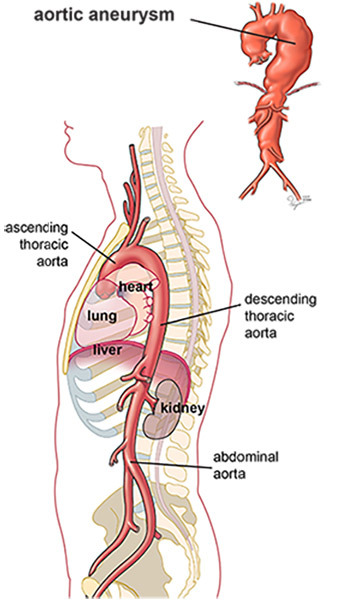What is an aortic aneurysm?

Your aorta is the largest artery in your body. Blood flows from your heart into your aorta. Smaller arteries branch off the aorta and carry blood to the rest of your body.
An aortic aneurysm is a bulge in your aorta. It happens when there is a weak spot in the aorta wall. The pressure of the blood pumping through the aorta causes the weak area to bulge out like a balloon.
What is an abdominal aortic aneurysm?
An abdominal aortic aneurysm (AAA) is an aneurysm in the section of your aorta that passes through your belly (abdomen). This is the most common type of aortic aneurysm.
What is a thoracic aortic aneurysm?
A thoracic aortic aneurysm (TAA) is an aneurysm that passes through your chest, and may be in your:
- Aortic root: The part of the aorta attached to your heart.
- Ascending aorta: The top part of your aorta, between the aortic root and aortic arch.
- Aortic arch: The bend in your aorta between the ascending and descending aorta.
- Descending aorta: The part of your aorta between the aortic arch and your belly.
Is an aortic aneurysm dangerous?
Rupture and dissection
An aneurysm can get bigger over time. If you have an aortic aneurysm, it is very important to see your healthcare provider for regular follow-up visits and tests to check the size of the aneurysm. A large aneurysm can cause the section of aorta to burst (rupture) or split (dissect), which causes life-threatening internal bleeding.
Blood clot
It is also possible for a blood clot to form in the aneurysm. Small pieces of the clot can break off and travel through your body. This can lead to a stroke, heart attack and problems with your organs and circulation.
How do I know if I have an aneurysm?
Symptoms of an aortic aneurysm
Most patients with aortic aneurysms do not have any symptoms, even if the aneurysm is large.
If you have an AAA, you may:
- Have pain in your belly (constant or on and off).
- A pulsing feeling in your belly.
If you have a TAA, you may:
- Have back pain (constant or on and off).
- Feel short of breath.
- Have trouble swallowing.
These symptoms are most common if you have a TAA in your aortic arch.
If the aneurysm bursts, it often causes:
- Sudden, severe pain.
- Shock.
- Fainting.
If you have any of these symptoms, call 911 to get emergency treatment right away.
Tests used to find an aortic aneurysm
- X-Ray: Many times, an aneurysms is found on an X-ray done for another reason.
- Ultrasound of your belly or heart (echocardiogram).
- CT Scan.
- MRI.
Screening for an AAA
If your risk of having an AAA is high, your healthcare provider may want you have an ultrasound.
Ask your insurance provider about coverage for the screening. Medicare covers a one-time AAA screening with your healthcare provider’s referral.
What increases my risk of an aortic aneurysm?
Your risk of having an aortic aneurysm is higher if you have health conditions, such as:
- Atherosclerosis (plaque build-up in your coronary arteries).
- High blood pressure.
- Diabetes.
- High cholesterol.
- Bicuspid aortic valve.
- An infection or injury that damages your aorta.
- Marfan syndrome or another type of condition that can cause weak blood vessel walls.
Your risk is also higher if you:
- Smoke.
- Have a family history of aortic aneurysm. If so, talk to your healthcare provider about genetic testing and counseling.
What type of care do I need if I have an aortic aneurysm?
See a Vascular Specialist
A vascular specialist will order tests to learn more about the size, shape and exact location of your aneurysm. These tests may include:
- High-resolution CT scan.
- Angiogram: An X-ray of your blood vessels.
- Transesophageal echocardiogram (TEE): Captures images of your aorta using a tube that is placed in your esophagus.
- Intravascular ultrasound: Captures images of your blood vessels from inside the vessels using a long, thin tube called a catheter.
Regular visits: Wait and watch
The wait and watch approach is a way to keep track of the size and growth of your aneurysm. You will see your healthcare provider and have a CT scan or ultrasound on a regular basis — usually every 6 to 12 months.
Depending on the test results and other factors, like your age and other health conditions, your healthcare provider may recommend surgery.
Surgery
Surgery to repair an aortic aneurysm can be done with a traditional/open approach or with an endovascular technique. Your healthcare provider will talk to you about the best option for you.